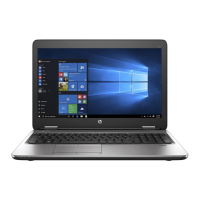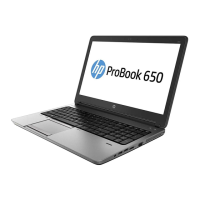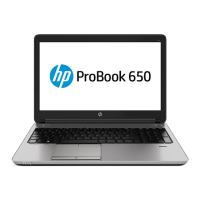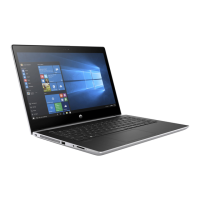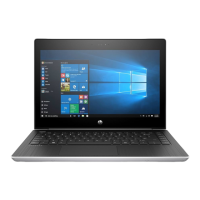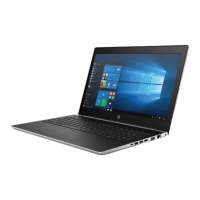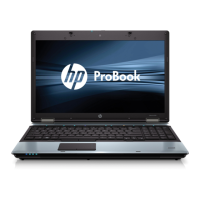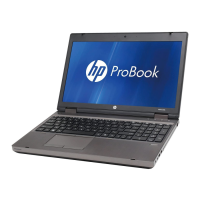Do you have a question about the HP ProBook 650 G5 and is the answer not in the manual?
Details components located on the right side of the computer.
Details components located on the left side of the computer.
Describes components and features of the computer's display.
Covers keyboard layout and pointing devices.
Explains the function of various indicator lights on the computer.
Details the power button, speakers, and fingerprint reader.
Describes the special function keys on the keyboard.
Lists keyboard hot keys available on specific models.
Describes components located on the bottom of the computer.
Information about labels affixed to the computer for identification.
Lists and illustrates the main internal components of the computer.
Details the components included in the cable kit.
Details the components included in the bracket kit.
Breaks down the display assembly into its constituent parts.
Lists and describes the computer's mass storage devices.
Lists plastic components and their part numbers.
Lists various miscellaneous parts and their part numbers.
Lists the necessary tools for disassembly and reassembly.
Key considerations for disassembly, handling parts, and cables.
Provides precautions for handling storage drives.
Best practices for workstation setup and ESD prevention.
Details how static electricity is generated.
Lists precautions to prevent ESD damage to components.
Describes methods and equipment for personal grounding.
Precautions for grounding the workstation and recommended ESD prevention materials.
Provides guidelines for packaging and transporting equipment safely.
General procedures for replacing customer-serviceable parts.
Steps to prepare the computer before disassembly.
Describes how to remove and replace the bottom cover.
Details the procedure for removing and replacing the battery.
Explains how to remove and install memory modules.
Provides steps for removing and replacing the optical drive.
Details the process for removing and replacing the hard drive.
Explains how to remove and install solid-state drives.
Procedure for removing and replacing the WWAN module.
Details the process for removing and replacing the WLAN module.
Steps for removing and replacing the keyboard.
Procedure for removing and replacing the internal frame.
Steps for removing and replacing the computer fan.
Details how to remove and replace the heat sink assembly.
Explains how to remove and replace the touchpad button board.
Procedure for removing and replacing the touchpad.
Steps for removing and replacing the NFC module.
Details the process for removing and replacing the smart card reader.
Explains how to remove and replace the RTC battery.
Procedure for removing and replacing serial or VGA port boards.
Details how to remove and replace the power button board.
Steps for removing and replacing the system board.
Procedure for removing and replacing the speakers.
Explains how to remove and replace the fingerprint reader assembly.
Details the process of removing and replacing the display assembly.
Guide to navigating and using the computer setup utility.
Instructions on how to enter the computer setup.
How to navigate menus and select options in setup.
Steps to reset BIOS settings to factory defaults.
Information on how to update the BIOS.
How to check the current BIOS version.
Instructions for downloading a BIOS update.
How to change the boot order during startup.
Configuring TPM settings in the BIOS.
Overview of the HP Sure Start feature for BIOS protection.
Guide to using the Windows-based hardware diagnostics tool.
Instructions for downloading the Windows diagnostics tool.
Steps to install the downloaded Windows diagnostics tool.
How to use the UEFI-based hardware diagnostics tool.
Steps to launch the UEFI diagnostics tool.
Guide to creating a bootable USB for UEFI diagnostics.
Instructions for downloading remote diagnostics settings.
How to configure remote diagnostics settings.
General requirements for power cord sets applicable worldwide.
Country-specific power cord requirements and certifications.
Using Windows tools to back up personal data.
Using Windows tools to create system restore points.
Using HP Cloud Recovery Tool for recovery media.
Overview of Windows recovery options.
Details on using Windows tools for backup and recovery.
Steps to create recovery media with the HP Cloud Recovery Tool.
Using Windows tools for system restore and refresh.
Steps to recover the system using HP Recovery media.
How to change the boot order to use recovery media.
Steps related to BIOS for memory management.
Information on nonvolatile memory types and their usage.
General hardware specifications for the computer.
Detailed specifications for the 14.0-inch display.
Specifications for M.2 PCIe solid-state drives.
Specifications for M.2 SATA solid-state drives.
Specifications for the computer's hard drives.
Details components located on the right side of the computer.
Details components located on the left side of the computer.
Describes components and features of the computer's display.
Covers keyboard layout and pointing devices.
Explains the function of various indicator lights on the computer.
Details the power button, speakers, and fingerprint reader.
Describes the special function keys on the keyboard.
Lists keyboard hot keys available on specific models.
Describes components located on the bottom of the computer.
Information about labels affixed to the computer for identification.
Lists and illustrates the main internal components of the computer.
Details the components included in the cable kit.
Details the components included in the bracket kit.
Breaks down the display assembly into its constituent parts.
Lists and describes the computer's mass storage devices.
Lists plastic components and their part numbers.
Lists various miscellaneous parts and their part numbers.
Lists the necessary tools for disassembly and reassembly.
Key considerations for disassembly, handling parts, and cables.
Provides precautions for handling storage drives.
Best practices for workstation setup and ESD prevention.
Details how static electricity is generated.
Lists precautions to prevent ESD damage to components.
Describes methods and equipment for personal grounding.
Precautions for grounding the workstation and recommended ESD prevention materials.
Provides guidelines for packaging and transporting equipment safely.
General procedures for replacing customer-serviceable parts.
Steps to prepare the computer before disassembly.
Describes how to remove and replace the bottom cover.
Details the procedure for removing and replacing the battery.
Explains how to remove and install memory modules.
Provides steps for removing and replacing the optical drive.
Details the process for removing and replacing the hard drive.
Explains how to remove and install solid-state drives.
Procedure for removing and replacing the WWAN module.
Details the process for removing and replacing the WLAN module.
Steps for removing and replacing the keyboard.
Procedure for removing and replacing the internal frame.
Steps for removing and replacing the computer fan.
Details how to remove and replace the heat sink assembly.
Explains how to remove and replace the touchpad button board.
Procedure for removing and replacing the touchpad.
Steps for removing and replacing the NFC module.
Details the process for removing and replacing the smart card reader.
Explains how to remove and replace the RTC battery.
Procedure for removing and replacing serial or VGA port boards.
Details how to remove and replace the power button board.
Steps for removing and replacing the system board.
Procedure for removing and replacing the speakers.
Explains how to remove and replace the fingerprint reader assembly.
Details the process of removing and replacing the display assembly.
Guide to navigating and using the computer setup utility.
Instructions on how to enter the computer setup.
How to navigate menus and select options in setup.
Steps to reset BIOS settings to factory defaults.
Information on how to update the BIOS.
How to check the current BIOS version.
Instructions for downloading a BIOS update.
How to change the boot order during startup.
Configuring TPM settings in the BIOS.
Overview of the HP Sure Start feature for BIOS protection.
Guide to using the Windows-based hardware diagnostics tool.
Instructions for downloading the Windows diagnostics tool.
Steps to install the downloaded Windows diagnostics tool.
How to use the UEFI-based hardware diagnostics tool.
Steps to launch the UEFI diagnostics tool.
Guide to creating a bootable USB for UEFI diagnostics.
Instructions for downloading remote diagnostics settings.
How to configure remote diagnostics settings.
General requirements for power cord sets applicable worldwide.
Country-specific power cord requirements and certifications.
Using Windows tools to back up personal data.
Using Windows tools to create system restore points.
Using HP Cloud Recovery Tool for recovery media.
Overview of Windows recovery options.
Details on using Windows tools for backup and recovery.
Steps to create recovery media with the HP Cloud Recovery Tool.
Using Windows tools for system restore and refresh.
Steps to recover the system using HP Recovery media.
How to change the boot order to use recovery media.
Steps related to BIOS for memory management.
Information on nonvolatile memory types and their usage.
General hardware specifications for the computer.
Detailed specifications for the 14.0-inch display.
Specifications for M.2 PCIe solid-state drives.
Specifications for M.2 SATA solid-state drives.
Specifications for the computer's hard drives.
| RAM | Up to 32 GB DDR4-2400 SDRAM |
|---|---|
| Storage | Up to 1 TB HDD or 512 GB SSD |
| Operating System | Windows 10 Pro |
| Battery | HP Long Life 3-cell, 48 Wh Li-ion |
| Processor | 8th Generation Intel Core i5/i7 |
| Display | 15.6-inch, HD (1366x768) or FHD (1920x1080) |
| Graphics | Intel UHD Graphics 620 |
| Weight | Starting at 2.18 kg |
| Ports | 1 USB 3.1 Type-C, 2 USB 3.1 Gen 1, 1 HDMI 1.4, 1 RJ-45, 1 headphone/microphone combo |
| Wireless | Intel Dual Band Wireless-AC 802.11a/b/g/n/ac (2x2) Wi-Fi and Bluetooth Combo |
